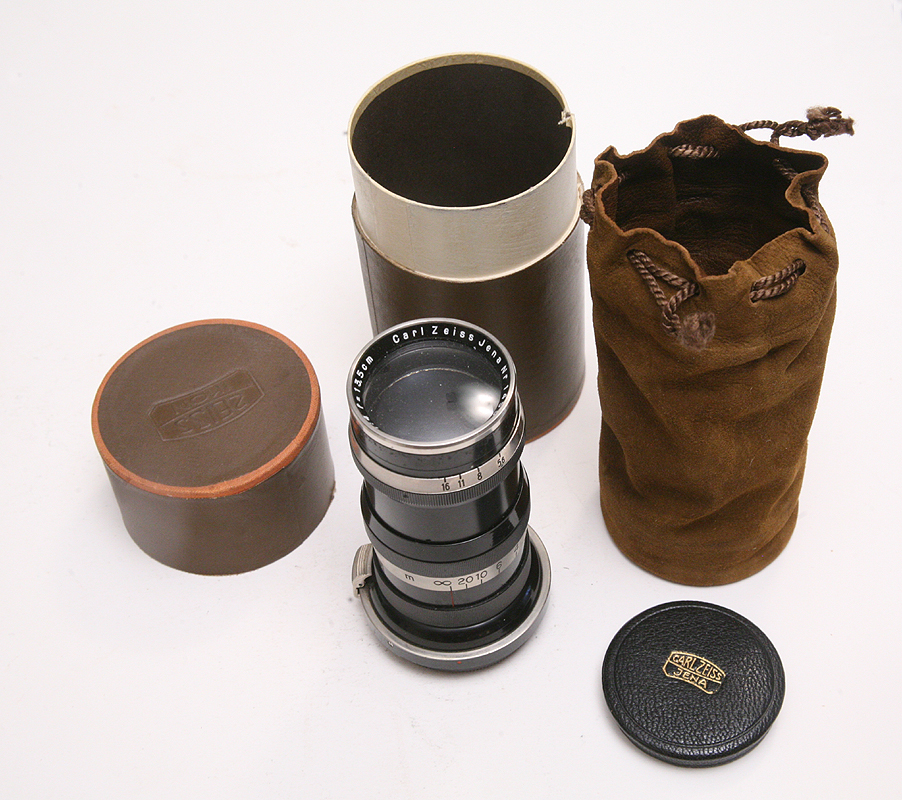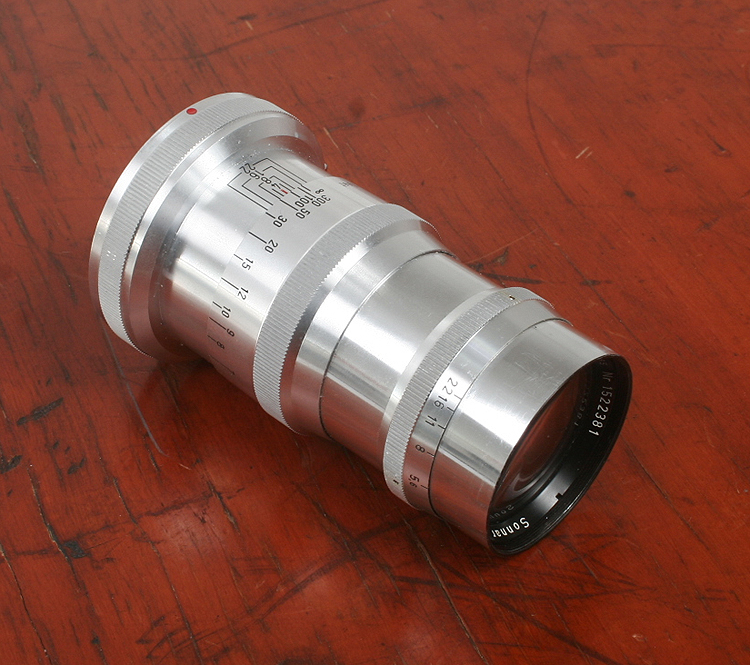
Photographica Pages
An online guide to collectable cameras and related stuff
135/4 Zeiss Sonnar for Contax

The 135/4 Sonnar, third version, with pouch case, leather cap and original box.
The 135mm lens was one of the most popular focal lengths for rangefinder cameras. I suspect that was
because it was the longest lens most rangefinders were accuarte enough to focus (however the Contax
had a longer rangefinder base than most, and Zeiss built rangefinder coupled 180mm lenses). The
135/4 Sonnar was a popular lens that changed numerous times over the years.
The 135/4 Sonnar, third version, with pouch case, leather cap and original box.
The original version came out in 1932, and was black and nickel. Serial numbers started at about 1368701. The scale on the aperture ring (which was on the lower end of the ring) and the entire focusing ring were finished in nickel. The lens lacked threads for filters, and the minimum aperture was f/32.
Later that same year the focus ring was only nickel on the scale, the grip was painted black. The minimum aperture was changed to f/16.
The third version was built in 1933. The difference was the aperture ring had the nickel scale moved from the rear of the ring to the front. Serial numbers run roughly from 1435401 to 1720000.
1935 saw the first of the 135mm chrome lenses. At first they were like the 1933 type, with no filter threads and a minimum aperture of f/16. Serial numbers 1631614 and 1631652 are two known examples. Other odd lenses have occured in this general serial number time frame, including lenses that are a mix of black, nickel and chrome. Later that year serial production in chrome began in numbers out of sequence. The first chrome lens is reputed to be 1505101, which would actually indicate 1934 production. Some overlap of black/nickel and chrome lenses appear to happened. These lenses also had the addition of 40.5mm filter threads and maintain the f/16 minimum aperture.
The optical design was changed in 1937 somewhere near serial number 2000000. The front element was bigger, and the rear element was made smaller. The minimum aperture was changed to f/22.
Lenses for the Luftwaffe were built in 1937-38 that were chrome, black and gray paint. Lenses were also built for the German navy marked MF and a four digit number. By 1939 the need for brass for shells drove Zeiss to make some lenses a hybrid brass and aluminum barrels.
The last wartime variation was a small batch of lenses in the 2847xxx range that were T coated.
The first postwar lenses came out of Jena in polished aluminum barrels with black noses. Optically they were the same as the prewar lenses, but they were coated. Serial numbers seem to start at 3053101. They werre brought out in 1947. In 1948 or 1949 a small number were built form chrome plated brass.
Oberkochen reformulated the lens in 1950 (although it is still a four element/three group design). They were marked Zeiss-Opton, and most carried the T designation (they were all coated). They wers built in batches 91201-93600, 661001-662000, 890401-892000 and 1130501-1131500 for a total of about 6100 lenses. In 1953 Zeiss changed the engraving from Zeiss-Opton to Carl Zeiss, and they lack the T designation as by know any decent lens was coated. Lenses were built in batches 13081011308700, 1344001- 1344200, 1522501-1523700, 1599801-1602800 and 1896501-1898600 for an estimated 7000 units.

The 1953 Carl Zeiss version.
